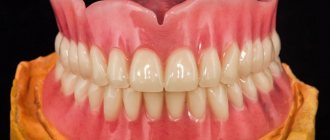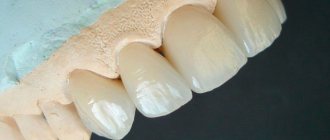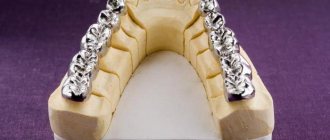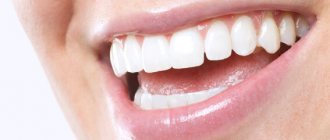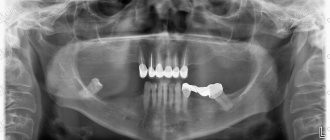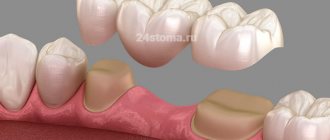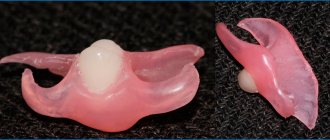Without exaggeration, zirconium crowns are a universal and technologically advanced orthopedic design. Strength and durability, like metal. And the aesthetics are like ceramic dentures. At the same time, dental crowns are comfortable and safe to wear, do not cause allergies, and do not harm the body.
In addition, a zirconium dioxide prosthesis can be installed on any dental unit - in the front row, on molars and premolars. The design is also suitable for fixing bridges of 2-3 teeth. Service life with proper use is from 10 to 15 years. Now more details.
Peculiarities
Modern prostheses are made from natural stone, zircon, which is white. Externally, the material resembles real teeth, and in terms of hardness and strength it is often compared to metal. Like everything natural, zirconium dioxide crowns are completely compatible with the human body, take root well and do not cause discomfort when worn constantly. Unlike metal ceramics, a zirconium prosthesis does not cause darkening of the gums, galvanism, and is suitable for people with high sensitivity to foreign materials.
The prosthesis is made using CAD/CAM computer technology - a painstaking and complex process that requires highly qualified doctors and dentists. This explains the high cost of the orthopedic design.
But if you look at the characteristics of zirconium crowns, it becomes clear that the investment is completely justified:
- The strength of the material is 2.5 times higher than that of ceramics (900-1000 MPa).
- The automated manufacturing process reduces the risk of errors, unlike manual production. The technology is so precise that often after installing crowns, additional grinding and turning of the prosthesis is not required.
- The aesthetic properties of a zircon prosthesis are slightly worse than porcelain crowns. They have lower capacity (less transparent). However, from the outside, it is difficult even for a specialist to distinguish zirconium crowns from real natural teeth.
If you need to make a crown on a damaged tooth, or restore an entire area with several missing teeth, you may face the problem of choosing a material for the prosthesis. Of course, only an orthopedic doctor can give the necessary recommendations, taking into account the depth of the lesion and the location of the tooth. But in order to better understand this issue, we will talk about the modern material used for the manufacture of orthopedic structures - zirconium dioxide.
If you want crowns to be no different from the rest of your teeth, then zirconium dioxide is what you need!
We keep up with the times and practically do not use metal and metal-ceramic crowns in our work. Most of our guests, when they come for a consultation with an orthopedic doctor, themselves ask for dental prosthetics with more durable and aesthetic designs.
What is zirconium dioxide?
Zirconium is a metal, but its dioxide is not. This compound contains transparent crystals that are not subject to change when exposed to water or temperature changes. Zirconium dioxide itself is soft - this allows you to create products of any size and any shape from it. But after the sintering (sintering) process, zirconium dioxide becomes strong and hard, not inferior to metal in these characteristics. This material is approximately 2-4 times stronger than ceramics used in prosthetics. It is thanks to this that structures made from it can withstand high loads and can last for decades.
A zirconium crown is a prosthesis that has a bright white color and is particularly durable. It is installed to replace the lost tissue of the crown part of the tooth or even the tooth or teeth itself (if prosthetics is carried out on an implant or using a bridge).
The melon type of structures is relatively young. In 1994, Matt Anderson introduced the Procera system to the dental community, a new technique for making zirconia crowns.
Zirconium crowns do not have a metal frame, so they can let light into the tooth, making them look more natural.
In addition, zirconium dioxide is not subject to corrosion and oxidation, and as a result, the gums above the crown do not darken over time (as happens with metal-ceramic dentures).
From all of the above, we conclude that zirconium crowns have clear advantages, namely
- The strength of the zirconium dioxide structure allows for the creation of extended bridges
- Thickness of tooth tissue preparation Possibility of keeping the tooth “alive”. Since the frame of zirconium dioxide crowns is quite thin (namely about 0.3-0.6 mm layer), it is not necessary to depulpate the tooth (remove the nerve), the pulp chamber is not damaged during the preparation process.
- Biocompatibility. Zirconium dioxide is a hypoallergenic material that combines ideally with tooth tissue, which avoids the occurrence of pathological processes. There is no need to injure the gum and “hide” the edge of the crown under it, since there is no dark metal edge on the crown. Also, the absence of metal eliminates pigmentation of the gums due to oxidation.
- No sensitivity to temperature changes.
- The prosthesis very accurately conveys all the anatomical features of the structure of the teeth.
- Durability. The warranty period for a zirconium microprosthesis is on average about 2-3 years. But for patients who maintain oral hygiene and regularly undergo professional cleaning by a hygienist, zirconium dioxide caps last 10-15 years. Moreover, they do not change shape and color throughout their entire service life.
- For more than 30 years, the use of zirconium dioxide in medicine has proven the biocompatibility of zirconium dioxide with any tissues of the body (as we said earlier). Including in the oral cavity!!!
- One of the most important qualities is also the absence of galvanosis effect.
- The highest aesthetic indicators also influence the choice! Color rendition and some transparency of the design allows you to make a prosthesis that is not noticeable in the oral cavity.
This type of prosthesis also has some disadvantages.
- The cost is primarily due to the complexity of manufacturing, as well as high quality and a fairly long service life, and the use of expensive computer equipment to create a prosthesis.
- Possibility of chips or cracks, but this is due to failure to follow recommendations for the use of prostheses or installation of a prosthesis in the presence of contraindications.
When is it not recommended to install zirconia crowns?
- for some malocclusion pathologies
- with hypertonicity of the masticatory muscles
- with bruxism
During the consultation, the doctor will determine whether there are contraindications for the use of orthopedic structures made of zirconium dioxide and will offer the best solution to the problem. Do I need special care for installed zirconium dioxide crowns?
There is no rule for cleaning teeth covered with zirconium crowns that differs from caring for your own teeth. You need to understand that home oral hygiene should be carried out 2 times a day (in the morning after tomorrow and in the evening before bed), both for natural teeth and for teeth covered with orthopedic structures. Of course, in addition to a toothbrush and toothpaste, you need to use dental floss and mouth rinse. An additional hygiene product is an irrigator. We recommend using this device for those who have orthopedic structures, including those made of zirconium dioxide.
Of course, professional oral hygiene 2 times a year is recommended. Home care is not enough to maintain proper hygiene. Hard-to-reach areas of the oral cavity, periodontal pockets, bridges - all this requires the work of a hygienist. Our dentists use special tools to perform professional hygiene with zirconium dioxide crowns.
Compliance with the recommendations of an orthopedic doctor for the care of crowns made of this material guarantees their long service life.
Our clinic has been specializing in orthopedic structures made of zirconium dioxide for many years. We offer patients single crowns, bridges, and crowns on implants made from this material. In many respects, zirconium dioxide, products from which do not deform over time, is superior to any dental alloys. Dentures made from this material are difficult to distinguish from the enamel of your own teeth in appearance, and are comparable in strength to this fabric. Being manufactured using high-precision equipment, these products are perfectly similar in shape to natural teeth and have a perfect fit to your own dental tissues.
Varieties
The issue of aesthetics helps to decide the type of design and manufacturing method. There are classic and monolithic types of crowns.
In the first case, a zirconium base is used as a frame. And ceramics are applied on top in several layers. Thus, the design perfectly combines the strength of zircon and the impeccable aesthetics of ceramics.
Monolithic crowns are made from a single block, without additional cladding. But the mineral in its “pure form” has a milky tint, and differs from natural teeth. Therefore, monolithic zirconium crowns are used to restore chewing teeth.
The second type of prosthesis is more reliable, because eliminates possible chips on metal-free ceramics. To improve aesthetics, manufacturers began to produce colored zircon blocks (for example, Prettau technology). These crowns can be used to restore teeth in the smile area.
There is a material similar in external properties to zirconium dioxide - aluminum oxide. But the design is less durable, so it is used less often and only for prosthetics of the front teeth.
Installation steps
1 Preparation
2 Taking impressions
3 Making a crown
4 Fitting, fixation
Includes: radiography, sanitation of the oral cavity, preparation of enamel, strengthening of the root with a stump insert (if necessary).
Using a digital camera, the doctor scans the tooth to be replaced. The resulting images are loaded into a computer program to model the frame of a future orthopedic structure. The clinic uses 3D scanning technology with blue backlight, which has replaced the outdated white backlight technology. It reduces sensitivity to ambient light and increases scanning quality/accuracy.
In a dental laboratory, an orthopedic structure is cut out on a milling machine according to a computer-specified shape.
The doctor tries on the crown and, if the patient does not experience any discomfort, fixes it onto the abutment tooth with dental cement. If the prosthesis is installed on an implant, it is screwed on.
Advantages of zirconium dioxide crowns
The popularity of zirconium crowns is due to many advantages.
The main thing is strength, which we have already talked about. Let us only add that the reliability of the prosthesis is confirmed by its use in complex bridge structures. The material is also used for prosthetics of the entire jaw, with complete or partial edentia. The second argument in favor of zircon is minimal grinding of the tooth when installing a prosthesis. The thickness of the crown is not at all large, so no more than 0.3-0.5 mm of enamel is removed from the supporting tooth. If the tooth is healthy and the pulp is not inflamed, then the dental nerve remains inside the tooth. This allows you to save your natural tooth for the maximum period, even if it is severely damaged.
Interestingly, throughout the entire period of use, zirconium dioxide crowns retain their external qualities. The surface of the prosthesis does not darken and is not subject to pigmentation. Zircon is also resistant to temperature changes, so the patient does not have a reaction to hot or cold food.
Making a prosthesis using digital technology ensures a tight fit of the internal cavity of the artificial tooth to the stump. This prevents the dental cement on which the prosthesis is attached from being washed out. As well as food getting and getting stuck inside the structure.
How teeth are treated for zirconium and metal-ceramic crowns
Before installing a zirconium crown or other types of artificial crowns, the teeth must first be prepared.
Turning for a zirconium crown
If we talk about zirconium crowns, then due to the zirconium dioxide in their base, the alloy is initially light in color, then for coating with ceramics, it does not need to be further masked by covering with special ceramic primer materials.
Due to this, the thickness of zirconium crowns can be less than the thickness of metal-ceramic crowns based on noble and base metals; accordingly, the degree of tooth processing for such a crown, grinding, will be less.
It is often possible to prepare teeth for zirconium crowns without first removing the nerves from them, of course, taking into account all medical indications and the condition of each specific tooth, but often crowns can be placed on living teeth.
Preparing a tooth for a metal-ceramic crown
If we are talking about metal-ceramic crowns, then due to the thickness of the crown, which contains a metal alloy, which still needs to be aesthetically closed so that it does not show through, and covered with ceramics, due to a certain number of layers of ceramics, a more vibrant appearance corresponding to the teeth is given.
The thickness of metal-ceramic crowns turns out to be greater, and often when preparing teeth for such crowns, it is necessary to remove the nerves of the teeth, in order to depulpate the teeth, so that there are no complications in the future if the tooth under such a crown hurts due to inflammation of the nerve.
Teeth from which the nerves have already been removed are, by default, less durable than living teeth.
Although, in certain situations, it is sometimes necessary to depulpate teeth under both types of crowns, this depends on medical indications, contraindications to depulpation, and removal of nerves from teeth.
Cons of zirconium crowns
Prostheses made of zirconium are considered the most expensive among their analogues, in terms of the cost of material and manufacturing methods. In addition, the ceramic layer in the classic design of zirconium crowns is less durable. Chips may appear on the surface of the tooth, and the structure will have to be repaired or replaced.
The imperfection of aesthetics also falls into the “cons” column. Monolithic zirconium cannot convey the natural translucency of tooth enamel, so with a single tooth replacement it may look unnaturally white. However, if you restore the entire front row, there will be no problems with aesthetics.
Due to its strength, the material can wear away the enamel of neighboring teeth. The degree of abrasion is insignificant, but it is necessary to visit an orthopedic dentist periodically, once every six months, to prevent the destruction of healthy teeth.
Features of care
Zirconium dentures do not require special care. The set of procedures does not differ from standard daily care for natural teeth:
- regular brushing with toothpaste without solid particles (containing abrasives);
- preference should be given to brushes designed for cleaning dentures;
- rinsing the mouth after eating;
- use of special superfloss threads.
The high strength of zirconium products allows you to consume products without any restrictions. Apples, carrots, hard chocolate and similar foods can be safely bitten with new teeth. However, you should not chop nuts, ice, or candy with the help of dentures.
A prerequisite for care is to visit the dentist at least once a year. Following the recommendations extends the life of artificial teeth, eliminating side effects such as cracks and chips.
Production process
As mentioned above, zirconium dental crowns are made using CAD/CAM computer technology. The first part of the abbreviation stands for computer modeling of prostheses. And CAM is the subsequent milling of crowns according to the developed three-dimensional model.
In other words, “manual” intervention in the process is minimized. This eliminates possible errors in the production of the structure associated with the human factor.
The prosthesis manufacturing process consists of several stages:
- To transfer data to the program, the dentist scans the oral cavity with a special scanner. This is done immediately after treating the supporting teeth.
- The program develops a virtual model of the jaw with a new prosthesis. At the same time, the doctor selects the shade for the crown according to the Vita scale.
- Based on the calculations, a three-dimensional model of the prosthesis is created, according to which a zirconium dioxide crown will be made using a milling cutter.
- The finished product is subjected to heat treatment. If the prosthesis is two-layer, then the zirconium dioxide base is “baked” first, and then a second time after lining with ceramics.
At the final stage, the dentist paints the crown in the desired shade and transfers the structure to the dentist. Production of the prosthesis takes 1-2 weeks, depending on the complexity of production.
Manufacturing stages
Zirconium dioxide is used to make two types of crown designs:
- Monolithic , consisting entirely of zirconium dioxide. They are characterized by increased strength, reliability, and a high degree of abrasion. Recommended for chewing teeth that do not require increased aesthetic beauty.
- Two-layer based on a zirconium dioxide frame with an applied outer porcelain layer. They are used for prosthetics of the frontal area - the “smile zone”. They have the aesthetic color and transparency of a natural human tooth.
High-tech equipment is used to produce zirconium crowns. The process is fully automated and occurs without human intervention using the CAD\CAM method. Includes several stages:
- computer development of a three-dimensional model of the future prosthesis;
- loading the finished 3D model into the control unit of the milling machine;
- creation of a frame made of zirconium dioxide according to specified parameters;
- firing in a special oven;
- application of several layers of porcelain by hand by a technician with sequential firing of each layer;
- manually applying the selected shade of dye;
- final firing.
The shade of the dye is selected according to the color of the patient’s natural tooth enamel. The service life of zirconium crowns is 15-20 years.
Bridges for any number of teeth are made from zirconium dioxide. They are a structure of individual crowns connected together, the outermost of which have a hollow structure. Bridges are mainly made non-removable. However, the possibility of a removable denture is not excluded. The design is supplemented with locks if necessary.
For the manufacture of dentures, three types of zirconium blanks are used, depending on the level of translucency (light transmission):
- Non-translucent with maximum strength up to 1500 mPa. They are used for prosthetics for patients with malocclusion and the absence of several teeth. Finished dentures are colored by placing them in a special composition before firing.
- Increased translucency with a strength of 900 mPa. Used to create individual crowns and bridge structures. Painting is done manually on the inside and outside with special brushes before firing.
- Ultra translucent with a strength of 1100 mPa and a light transmittance of 30%. They are used to create individual crowns and veneers that are particularly aesthetically attractive. The coloring process is identical to the process for products made from non-translucent zirconia compounds. Most often, this variety is used for crowns in the “smile zone”. Can be used to make bridges with no more than three teeth.
Installation of crowns
The procedure for fixing a zirconium dioxide crown to a tooth is standard. First, the doctor conducts an initial examination and diagnosis of the jaw to determine the condition of the oral cavity. If the patient requires preliminary treatment, the installation of the prosthesis is postponed until therapy is carried out.
If there are no pathologies, the dentist carries out professional teeth cleaning to remove soft and hard plaque. Then the doctor begins to grind the restored teeth. If the tooth is severely damaged, a pin, inlay or implant can be used as support.
If the root of the tooth is not damaged, then it is filled and the font is fixed on top. If the patient is allergic to metal, then a rod made of zirconium or titanium can be used. This method is not applicable in the presence of periodontal pathologies. And also in the presence of diseases of the nervous system.
The stump tab is also installed in the sealed root canal and ensures reliable fastening of the prosthesis. But the most common technique is fixing a zirconium crown to an implant. It is used when a tooth is missing. The titanium rod imitates a tooth root, preventing bone tissue atrophy. The material is biocompatible with the human body and fuses seamlessly with the jaw bone.
The process of attaching the crown to the supporting tooth or pin takes about 30 minutes. The structure is fixed with dental cement under the influence of light. Sometimes a so-called “temporary mixture” is used so that the patient can test the prosthesis as usual. If defects appear during wearing, the design is sent to the laboratory for revision. At the final stage, the zirconium crowns are placed on the support using dual-curing cement.
Indications
1
The tooth is destroyed
2 Tooth missing
3 Lost several units in a row
4 Completely edentulous
When a unit is severely damaged by caries (up to 50%) or has suffered serious mechanical trauma and cannot be restored with a filling, then the installation of a zirconium crown is recommended. The enamel is ground down minimally (in most cases, depulpation, i.e., removal of the nerve, is not required). If only the root remains, then the prosthesis is fixed to the stump tab.
First, a dental implant is installed to replace the tooth root. If the clinical situation allows, the prosthesis is fixed to the implant on the same day.
A zirconia bridge is placed on adjacent teeth or on implants. This is the best solution for replacing 2-4 missing units in a row.
A complete denture with 12 or 14 zirconium crowns is fixed on 4 or 6 implants (depending on the clinical picture) using all-on-4 or all-on-6 technology.
Adaptation
The procedure for fixing zirconium crowns does not have a recovery period. The only restriction is not to eat food for 2-3 hours after installation of the prosthesis.
Of course, at first you may experience unusual sensations from the presence of a foreign structure in your mouth. There may be slight disturbances in diction, increased salivation, and discomfort in the facial muscles. As a rule, these sensations disappear after a few days, after the patient gets used to the new teeth. If discomfort persists or worsens, you should immediately consult a dentist. You should not try to straighten the structure yourself - this can lead to its breakdown and health problems.
Is it possible to save money on installing zirconia crowns in the smile area?
Theoretically it is possible, but is it worth it? Different dental laboratories use different zirconium blocks from which crowns are made. You can save your budget by choosing a traditional material in which the zirconium blocks have a milky tint. However, in this case the aesthetics will not be ideal.
If you want a truly beautiful smile zone, to smile freely and widely, experts do not recommend skimping on installation. You can choose a product made from translucent zirconium blocks that have higher levels of transparency and shades.
Recently, dentists have been using so-called hybrid crowns - a combination of zirconium dioxide and glass ceramics. This option is considered the most expensive, but in terms of its reliability, performance characteristics and aesthetics it is at its best!
Lifetime
A zirconia prosthesis does not have a fixed service life. On average, this is 10-15 years. With careful care and wear, crowns can last much longer. This depends on the condition of the teeth, the quality of the installation of the prosthesis and regular oral hygiene.
What can cause damage or damage to the structure:
- Lack of tightness. The reason is usually careless handling of the prosthesis, as well as poor quality material.
- Recession (exposed gums). Occurs due to inflammation in soft tissues. Or due to improper hygiene.
- Destruction of hard tooth tissues (periodontal disease, bruxism, inflammation).
Dental trauma caused by eating hard foods or lack of calcium in the body can also damage the prosthesis.
Life time
The service life of the product may be reduced for several reasons:
- loosening of the tooth due to developing periodontal disease or periodontitis, less often due to the absence of an adjacent tooth or bruxism;
- violation of the tightness of a two-layer crown due to the use of low-quality materials or careless handling on the part of the patient;
- tooth decay due to reasons: hormonal imbalances, metabolic disorders, poor dental care, lack of calcium.
- chipping or breaking of the crown as a result of injury, biting hard food, malocclusion or bruxism.
Contraindications
The restrictions on installing zirconium crowns are the same as with standard prosthetics. Contraindications include bruxism, the presence of inflammatory processes in the oral cavity in the body as a whole, and chronic diseases in the acute stage. As well as malocclusion, blood clotting disorders, and the rehabilitation period after surgery.
Rules of care
Although zirconia crowns are not susceptible to decay, deposits on the surface of artificial teeth can lead to damage to adjacent teeth, bad breath, and poor digestion.
In addition to brushing your teeth, it is recommended to use dental floss and irrigators to remove food debris in the interdental space. A special oral solution also helps get rid of bacteria.
Do not overuse very hard foods, do not crack the shells of nuts and seeds with your teeth. This may damage the surface of the prosthesis. Especially, the surface of zirconium crowns with ceramic veneer.
If you smoke, try to quit this habit. Tobacco leaves a yellow coating on the teeth that cannot be removed even by professional cleaning. In this case, the prosthesis will have to be changed after 2-3 years.
Visit your dentist's office every six months. The doctor will conduct professional oral hygiene and promptly identify the development of pathologies.
For which teeth is a zirconium crown suitable?
This is a suitable solution for the manufacture of fixed dentures for any tooth. There are minor differences between dentures. A ceramic-coated crown is placed on the front teeth, which are visible when you smile. It makes the prosthesis invisible - its color matches the rest of the dental units, and in the light it acquires a pleasant shine. For chewing teeth, all-zirconium dentures are used - not so shiny and without a translucent effect, but more durable. The products do not chip and can withstand the highest loads.
A zirconium crown on a tooth repeats all the anatomical features of the native dental units. Therefore, the prosthesis is also called an anatomical crown.
Price of zirconium crowns
The cost of zirconium crowns is influenced by the material, the chosen production and installation method, as well as the doctor’s qualifications. If the dentist chooses the method of prosthetics, then the responsibility for choosing a specialist lies on the shoulders of the patient. After all, your future health depends on who you entrust with dental treatment. Redoing someone else's poor-quality work is not only difficult, but also very expensive.
On average, the price of a zirconium dioxide prosthesis ranges from 15 thousand rubles and more. To receive qualified dental care, pay attention to whether the clinic has its own dental laboratory. And what equipment does a specialist use when producing a zirconium prosthesis?
At EspaDent clinics you can undergo a free initial diagnosis and find out the final cost of the procedure before treatment begins.
Advantages of dental prosthetics at the EspaDent clinic
- Diagnostics . At your service is a premium computer tomograph Sirona Ortophos SL 3D (Germany), which allows you to accurately plan treatment. The result of prosthetics can be assessed on the computer screen even before the manipulations begin.
- Implantation . The operation to install implants is quick and painless. The EspaDent clinic uses low-traumatic methods and uses 3D surgical templates.
- Manufacturing . Zirconium crowns are made in our laboratory, so the process takes a minimum of time. The latest CAD/CAM equipment operating in automatic mode is responsible for accuracy.
- Installation . We install permanent dentures with zirconium crowns on implants only after they are completely stabilized in the bone.
The article was checked by: Aivazov Tigran Georgievich
If you liked this post, share it with your friends and subscribers.
Advantages and disadvantages of zirconium crowns
Products made from zirconium dioxide have a number of advantages in comparison with popular metal-ceramics and other structural materials:
- minimal grinding of teeth due to the thinness of the crown walls;
- The light transmittance of zirconium makes implants close to natural teeth with their inherent transparency. This allows you to achieve maximum aesthetic effect;
- safety for the human body in general, absence of allergic reactions in particular;
- quick survival, no discomfort;
- possibility of installation on implants;
- computer technology allows you to create products with high accuracy of size and shape with a small thickness (0.4 mm);
- minimal tooth processing by grinding, no need to remove pulp;
- throughout their entire service life, products made from zirconium dioxide do not change color and retain their aesthetic appeal, which makes them an ideal option for prosthetics of front teeth;
- absence of blue gums around the tooth, characteristic of metal-ceramic crowns;
- do not cause bleeding gums;
- high degree of wear resistance;
- tight fit to the gums, preventing food from getting under the crown. The reduced risk of caries in the abutment tooth makes them an ideal option for chewing teeth.
There are few disadvantages to zirconium crowns:
- high price due to the significant cost of materials and the use of computer technology (minimum cost - from 15-16 thousand rubles per unit).
With full prosthetics, the cost is reduced by installing combined crowns. Zirconium is installed on the front teeth, metal ceramics are installed on the side teeth.
As with prosthetics with other structural materials, minor complications may arise after installation of zirconium products:
- Periodontal inflammation under the crown. Occurs when the root canal is incompletely filled. Leads to the need to remove the crown and re-treat the tooth. It is extremely rare; the installation of a permanent prosthesis occurs after treatment of the tooth and periodontal tissues with preliminary prosthetics with a temporary structure.
- Poor fit to the tooth. Computer technology minimizes all possible errors in size and shape, provided that the impressions are taken correctly.
- The color of the crown differs from the color of healthy teeth. Error in choosing a shade using the Vita comparative scale.
Computer technology reduces the risk of human errors to zero. However, the preparatory and final stages completely depend on the professionalism of the dentist-therapist and orthopedic dentist.

